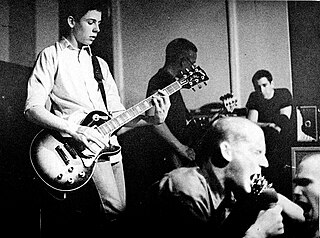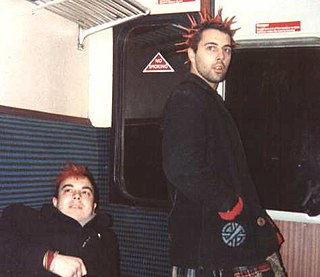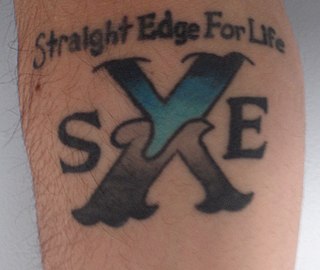Grindcore is an extreme fusion genre of heavy metal and hardcore punk that originated in the mid-1980s, drawing inspiration from abrasive-sounding musical styles, such as thrashcore, crust punk, hardcore punk, extreme metal, and industrial. Grindcore is considered a more noise-filled style of hardcore punk while using hardcore's trademark characteristics such as heavily distorted, down-tuned guitars, grinding overdriven bass, high-speed tempo, blast beats, and vocals which consist of growls, shouts and high-pitched shrieks. Early groups like Napalm Death are credited with laying the groundwork for the style. It is most prevalent today in North America and Europe, with popular contributors such as Brutal Truth and Nasum. Lyrical themes range from a primary focus on social and political concerns, to gory subject matter and black humor.

The punk subculture includes a diverse and widely known array of ideologies, fashion, and other forms of expression, visual art, dance, literature, and film. Largely characterised by anti-establishment views, the promotion of individual freedom, and the DIY ethics, the culture originated from punk rock.

Turku is a city and former capital on the southwest coast of Finland at the mouth of the Aura River, in the region of Finland Proper (Varsinais-Suomi) and the former Turku and Pori Province. The region was originally called Suomi (Finland), which later became the name for the whole country. As of 31 March 2021, the population of Turku was 194,244 making it the sixth largest city in Finland after Helsinki, Espoo, Tampere, Vantaa and Oulu. There were 281,108 inhabitants living in the Turku Central Locality, ranking it as the third largest urban area in Finland after the Capital Region area and Tampere Central Locality. The city is officially bilingual as 5.2 percent of its population identify Swedish as a mother-tongue.

Hardcore punk is a punk rock music genre and subculture that originated in the late 1970s. It is generally faster, harder, and more aggressive than other forms of punk rock. Its roots can be traced to earlier punk scenes in San Francisco and Southern California which arose as a reaction against the still predominant hippie cultural climate of the time. It was also inspired by Washington D.C. and New York punk rock and early proto-punk. Hardcore punk generally disavows commercialism, the established music industry and "anything similar to the characteristics of mainstream rock" and often addresses social and political topics with "confrontational, politically-charged lyrics."
Anarcho-punk is ideological subgenre of punk rock that promotes anarchism. Some use the term broadly to refer to any punk music with anarchist lyrical content, which may figure in crust punk, hardcore punk, folk punk, and other styles.

Punk fashion is the clothing, hairstyles, cosmetics, jewellery, and body modifications of the punk counterculture. Punk fashion varies widely, ranging from Vivienne Westwood designs to styles modeled on bands like The Exploited to the dressed-down look of North American hardcore. The distinct social dress of other subcultures and art movements, including glam rock, skinheads, greasers, and mods have influenced punk fashion. Punk fashion has likewise influenced the styles of these groups, as well as those of popular culture. Many punks use clothing as a way of making a statement.
Skate punk is a skater subculture and punk rock subgenre that developed in the 1980s. Originally a form of hardcore punk that had been closely associated with skate culture, skate punk evolved into a more melodic genre of punk rock in the 1990s similar to pop punk. Since then, it has predominately featured fast tempos, lead guitar playing, fast drumming, and singing. Occasionally, skate punk also combines the fast tempos of hardcore punk and melodic hardcore with the catchy hooks of pop-punk.
The music of Finland can be roughly divided into categories of folk music, classical and contemporary art music, and contemporary popular music.
Digital hardcore is a fusion genre that combines hardcore punk with electronic dance music genres such as breakbeat, techno, and drum and bass while also drawing on heavy metal and noise music. It typically features fast tempos and aggressive sound samples. The style was pioneered by Alec Empire of the German band Atari Teenage Riot during the early 1990s, and often has sociological or far-left lyrical themes.
Post-hardcore is a punk rock music genre that maintains the aggression and intensity of hardcore punk but emphasizes a greater degree of creative expression. It was initially inspired by post-punk and noise rock. Like post-punk, the term has been applied to a broad constellation of groups. Post-hardcore began in the 1980s with bands like Hüsker Dü and Minutemen. The genre expanded in the 1980s and 1990s with releases by bands from cities that had established hardcore scenes, such as Fugazi from Washington, D.C. as well as groups such as Big Black and Jawbox that stuck closer to post-hardcore's noise rock roots. In the early- and mid-2000s, post-hardcore achieved mainstream success with the popularity of bands like My Chemical Romance, Dance Gavin Dance, AFI, Underoath, Hawthorne Heights, Silverstein, The Used, At the Drive-In, Saosin, Alexisonfire, and Senses Fail. In the 2010s, bands like Sleeping with Sirens and Pierce the Veil achieved mainstream success. Meanwhile, bands like Title Fight and La Dispute experienced underground popularity.
Minneapolis hardcore is regional hardcore punk from the Minneapolis-St. Paul area of Minnesota.

Melodic hardcore is a broadly defined subgenre of hardcore punk with a strong emphasis on melody in its guitar work. It generally incorporates fast rhythms, melodic and often distorted guitar riffs, and vocal styles tending towards shouting and screaming. Nevertheless, the genre has been very diverse, with different bands showcasing very different styles. Many pioneering melodic hardcore bands, have proven influential across the spectrum of punk rock, as well as rock music more generally. The term "melodic punk" is often used to describe both melodic hardcore and skate punk bands.
Since the mid-1970s, California has had thriving regional punk rock movements. It primarily consists of bands from the Los Angeles, Orange County, Ventura County, San Diego, San Fernando Valley, San Francisco, Fresno, Bakersfield, Alameda County, Sacramento, Lake Tahoe, Oakland and Berkeley areas.

2. Divisioona is the fourth highest level of ice hockey in Finland. Teams playing in 2. Divisioona can be relegated to 3. Divisioona or promoted to Suomi-sarja. From 1975 to 1999, 2. Divisioona was the third highest level of ice hockey in Finland before being replaced by Suomi-sarja.
Crossover thrash is a fusion genre of thrash metal and hardcore punk. The genre lies on a continuum between heavy metal and hardcore punk. Other genres on the same continuum, such as metalcore and grindcore, may overlap with crossover thrash.
Punk rock and hardcore punk in Brazil originated in the late 1970s, influenced by bands such as Sex Pistols, The Clash, Stiff Little Fingers and The Ramones. The first known Brazilian punk rock band was Restos de Nada, which appeared in mid-1978 and set the stage for the emergence of many other bands that formed the Brazilian punk scene.

International Superheroes of Hardcore were an American parodical hardcore punk band.

Straight edge is a subculture of hardcore punk whose adherents refrain from using alcohol, tobacco, and other recreational drugs, in reaction to the excesses of punk subculture. For some, this extends to refraining from engaging in promiscuous sex, to following a vegetarian or vegan diet, and to not using caffeine or prescription drugs. The term straight edge was adopted from the 1981 song "Straight Edge" by the hardcore punk band Minor Threat.
Beatdown hardcore is a subgenre of hardcore punk with prominent elements of heavy metal. Beatdown hardcore features aggressive vocals, down-tuned electric guitars, gang vocals, heavy guitar riffs, and heavy breakdowns. The genre emerged in the late 1980s and early 1990s with bands such as Killing Time, Madball, and Sheer Terror. In the mid-late 1990s and early 2000s, many other beatdown bands emerged, such as Hatebreed, Bulldoze, Shai Hulud, and Strife. Bands such as Terror and Death Before Dishonor gained cult followings in the mid–late 2000s. New York hardcore bands such as Agnostic Front, Warzone, Sick of It All, and Cro-Mags and the thrash metal subgenre crossover thrash paved the way for beatdown.







